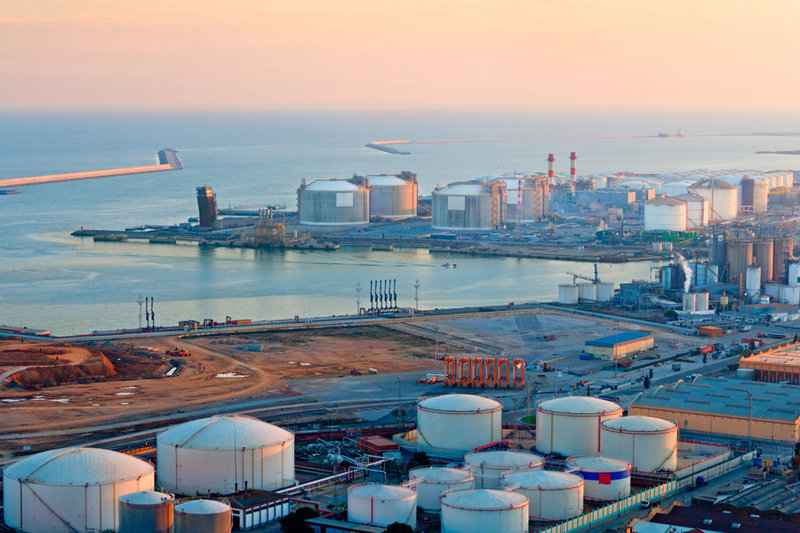Operations
LNG in shipping:
could space tech lighten the load?
Athens-based marine consultancy Ocean Finance is working with partners on SpaceTech4Sea, an innovative project using the aerospace industry’s lightweight LNG tank technology to make the fuel more viable for shipowners. Chris Lo discusses the project and its benefits with Ocean Finance director Panayotis Zacharioudakis
Image courtesy of
As the International
Maritime Organization (IMO), the European Union and national governments around the world continue the gradual process of tightening emissions standards for commercial vessels, liquefied natural gas (LNG) is starting to gain traction as an early alternative to traditional, highly polluting fuels such as heavy fuel oil and marine gasoil.
LNG is widely considered to be a suitable transition fuel on the shipping industry’s course to more environmentally sustainable operations. It emits virtually no sulphur oxides (SOx) and can significantly reduce emissions of harmful CO2, nitrogen oxides (NOx) and particulate matter. The cooling tanks used for LNG would also be suitable for the longer-term transition to hydrogen fuels, which will likely be the industry’s ultimate environmental solution in the coming decades.
But while a small number of ships are making use of LNG propulsion, adoption has been slow for a transition fuel that is expected to have a role for only 20 to 30 years. A host of obstacles stand in its way, from sparse infrastructure and regulatory frameworks on the supply side, to the expense of installing LNG equipment for shipowners, which restrains demand.
As well as cost, the weight of associated onboard LNG equipment is also a major problem for shipping firms, as the vastly increased weight of metallic LNG tanks makes vessels less efficient in terms of payload capacity.
This is where SpaceTech4Sea comes in. The project was initiated by Athens-based marine consultancy Ocean Finance along with partners Scorpius Space Launch Company and the American Bureau of Shipping, and involves the development of a lightweight, carbon fibre LNG tank based on technology currently used in the aerospace and space launch industries.
Here, Ocean Finance director Panayotis Zacharioudakis discusses the project, the challenges of LNG tanks for shipowners and the benefits of bringing space-ready technologies to the shipping sector.

Panayotis Zacharioudakis, director of Ocean Finance.
Image courtesy of Ocean Finance
Chris Lo:
What are the technical issues with LNG fuel tanks in shipping?
Panayotis Zacharioudakis: In parallel, as a company we are executing a project named SuperGreen. This project involves the construction of LNG fuel vessels in Greece. This is a project that has received €4m as a grant, and the Greek national gas provider DEPA is participating. Also we have a very big maritime operator as the major sponsor of the project, but I cannot disclose the name. This was why we started SpaceTech4Sea.
When we calculated the extra weight of the LNG-related equipment, we saw that it would be approximately 20% of the total weight of the vessel. This is catastrophic for a high-speed vessel, because we have a vessel that we will make out of carbon fibre – you pay a lot of money so you have a light ship with an innovative light-weight material, and on the other hand you penalise your operation by using an alternative fuel like LNG, which adds an additional 20% weight on the vessel. Most of this weight comes from the fuel system, not from the engine.
The fuel tank would be between six to eight tonnes for a 13 cubic metre tank, but if we go for an all-composite tank, we can go to less than one tonne. So we’re saving a lot of tonnes. It’s very critical to get rid of this extra weight, because based on these calculations, this 20% extra weight will require significantly increased installed horsepower on the vessel. For these reasons you don’t see, right now, high-speed vessels with LNG. This is practically the reason, because a high-speed [vessel] has to be light-weight, and light-weight and LNG are not compatible.
CL: When did you identify the aerospace industry as the sector that could bring the kinds of innovations you’re looking to achieve in shipping with SpaceTech4Sea?
PZ: This started around two years ago, when we initiated the discussion with our American partners. The first step was to have the ITAR [International Traffic in Arms Regulations] clearance for this technology, because this is aerospace technology that is being used for space and military applications. We did this successfully in May 2018.
The Commission had a facility that was assisting companies to develop products for the maritime industry. We applied to the Commission and we received approximately €1.1m as a grant to first modify this technology so that it will be suitable for the marine environment. It’s more of a downgrade of the technology rather than a modification, because the technology withstands the very difficult environment of space applications, so the maritime applications don’t have such extreme conditions. So it was a downgrade so we could also have a more attractive price.
So we are certifying this new product with ABS [American Bureau of Shipping], and we hope that by the end of 2019, this product will be available for the maritime industry, and at a very attractive price.

Image courtesy of
CL: What’s your roadmap for making this product available by the end of the year?
PZ: The next three to four months will be spent doing the necessary modifications. This has to do mainly with requirements for the holding tank, because this has most of the differences from the aerospace applications. Then we need to look at the insulation of this tank, because in aerospace it’s totally different from what we would have on the vessels.
Right away we will start with the certification tests, and most probably by the end of the summer, at the latest in 2019, the product will have class approval from ABS. So first of all modification, then certification, and then they will issue the class approval.
CL: How did you come to partner with Scorpius Space Launch Company on SpaceTech4Sea?
PZ: This company has this technology; they own the technology, the patents, and the licenses. We have an agreement in principle for a license that will give us the opportunity to have the commercial exploitation of the product. So we’re waiting for this product to be finalised, and then we will have the final license agreement.
Both sides feel this is a win-win. [Scorpius has] a very successful operation in space applications; they have supplied a lot of tanks to Lockheed Martin, to NASA, to these kinds of companies. Now they also feel that there is great potential for these kinds of tanks in the maritime business.
We also see some applications that are not limited to LNG, because this is a technology that can work also for other cryogenic fuels. We can see solutions for liquid hydrogen, or slush hydrogen, which is a new technology. This is what will be the optimum solution for us as a fuel.
CL: How scalable is this technology in terms of offering it to the wider industry? Are you aiming to set up a new construction hub for the tanks in Greece?
PZ: This is the provision of SpaceTech4Sea, that there will be a transfer of knowledge so that by using incentives from the Commission and also by blending with private equity, we will be able to install a production line here in Europe, most probably in Greece. This is also the key challenge for us, because right now the tank is hand-crafted. By doing this automation, we see that it can go even lower in price, compared to metallic tanks.
We have seen that we can install more than 2,000 tanks in the next five to ten years, based on the fleet right now, as it is in the Mediterranean Sea and across Europe, and what can be the most suitable cases to use this tank. This tank can be placed in newbuilds, but also it could be a very good opportunity for retrofit.
One big obstacle for retrofit is that not only do you have to install the new equipment, but because you have to install such heavy weights, you have to make special reinforcements to the hull to support the equipment. So for a lot of vessels, they cannot afford to have LNG tanks on board because they are so heavy and they have to reinforce the whole hull to support this extra weight. By installing these types of tanks, you limit the necessary retrofit of the vessel.